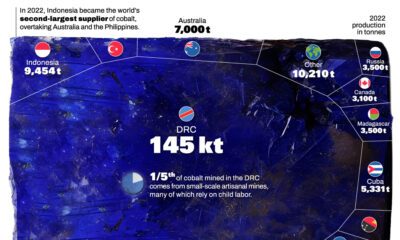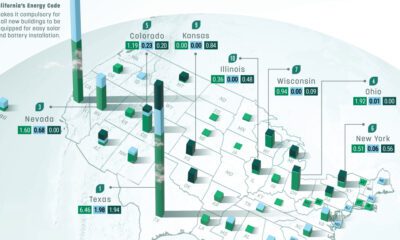
LFP Batteries for Electric Vehicles
Even though the technology behind EVs has evolved significantly over the past decade, batteries have always been a critical component.
Lithium iron phosphate (LFP) batteries are becoming an increasingly popular choice for standard-range EVs, with major automotive producers like Tesla and Ford introducing LFP-powered vehicles into their catalog.
In this infographic, our sponsor First Phosphate highlights the advantages of using LFP cathode batteries in EVs.
Benefit 1: Safety
LFP batteries are among the safest types of lithium-ion batteries, with a low risk of overheating and catching fire.
These batteries are less prone to thermal runaway and do not release oxygen if they catch fire, making them safer than other lithium-ion batteries.
Benefit 2: Long Life Cycle
LFP batteries have a longer lifespan than other types of lithium-ion batteries due to their low degradation rate. Meaning they can be charged quickly without significant battery damage, therefore leading to a longer lifespan.
LFP batteries can also withstand a larger number of charge and discharge cycles, meaning they can last longer before needing to be replaced.
Benefit 3: Cost-Effective
The materials used to produce LFP batteries are also relatively cheap compared to other types of lithium-ion batteries.
The main cathode materials used in LFP batteries are iron and phosphate, and they are in relative abundance in contrast to other battery metals. This makes them a cost-effective option for a variety of energy storage applications.
Benefit 4: Environmentally Sustainable
LFP batteries are environmentally sustainable because they are non-toxic and do not contain harmful heavy metals such as cobalt or nickel.
The materials used in these batteries are easier to source ethically, which makes them a more sustainable option than other types of lithium-ion batteries.
What’s Inside the Battery?
Most EVs utilize battery packs consisting of multiple individual battery cells. Similar to other types of lithium-ion batteries, LFP battery cells are made up of several components.
| Cathode | 43% |
| Anode | 31% |
| Electrolyte | 20% |
| Cell Container | 4% |
| Separator | 2% |
The cathode is the battery’s positive electrode and impacts its performance. It determines aspects such as energy capacity, charging and discharging speed, and the risk of combustion.
In LFP batteries, the cathode composition consists of three elements.
| Phosphate | 61% |
| Iron | 35% |
| Lithium | 4% |
Today, these batteries are becoming increasingly popular in standard-range EV models. LFP market share has significantly increased, reaching its highest share in the past decade at 30% of the market in 2022, according to the International Energy Agency (IEA).
First Phosphate is a mineral development company fully dedicated to extracting and purifying phosphate for the production of cathode active material for the LFP battery industry.

Click here to download First Phosphate’s Investor Deck now.

-
![]()
![]() Energy3 months ago
Energy3 months agoVisualized: How Much Do EV Batteries Cost?
The cost of electric vehicle batteries can vary based on size and chemical composition. Here are the battery costs of six popular EV models.
-
![]()
![]() Batteries6 months ago
Batteries6 months agoRanked: The World’s Top Cobalt Producing Countries
Cobalt, an essential component for certain types of EV batteries, has seen a significant shift in its global production landscape.
-
![]()
![]() United States8 months ago
United States8 months agoMapped: Renewable Energy and Battery Installations in the U.S. in 2023
This graphic describes new U.S. renewable energy installations by state along with nameplate capacity, planned to come online in 2023.
-
![Oil-Displaced-from-EV]()
![Oil-Displaced-from-EV]() Energy9 months ago
Energy9 months agoHow EV Adoption Will Impact Oil Consumption (2015-2025P)
How much oil is saved by adding electric vehicles into the mix? We look at data from 2015 to 2025P for different types of EVs.
-
![]()
![]() Batteries9 months ago
Batteries9 months agoGlobal EV Production: BYD Surpasses Tesla
This graphic explores the latest EV production data for 2022, which shows BYD taking a massive step forward to surpass Tesla.
-
![battery manufacturing capacity by country infographic]()
![battery manufacturing capacity by country infographic]() Energy1 year ago
Energy1 year agoVisualizing China’s Dominance in Battery Manufacturing (2022-2027P)
This infographic breaks down battery manufacturing capacity by country in 2022 and 2027.
The post 4 Benefits of LFP Batteries for EVs appeared first on Visual Capitalist.














